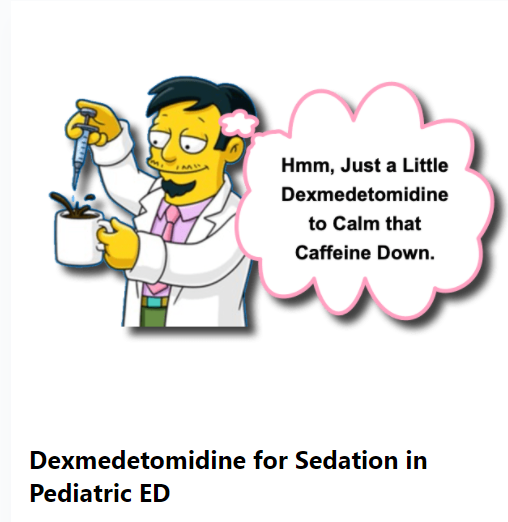In this post, I link to and excerpt from Pediatric EM Morsels‘ Dexmedetomidine for Sedation in Pediatric ED. DR SEAN M. FOX, JANUARY 28, 2022.
All that follows is from the above outstanding resource.
Keeping patients (and family members) calm and comfortable is an important aspect of having a successful shift. It is also challenging to do in our unique and chaotic environments (AKA The ED). We have discussed several options and strategies to help achieve the calm atmosphere we all desire (ex, Nitrous Oxide, Ketamine for Analgesia, Ketofol, Intranasal Medications), but recently we have been hearing about another option. Let us take a minute to digest a morsel on Dexmedetomidine for Sedation in the Pediatric ED:
Dexmedetomidine for Sedation
Dexmedetomidine is an alpha-2 agonist.
- It can provide anxiolytics, analgesia, or sedation.
- The analgesic effects are still unclear.
- May be altered perception due to reduction in anxiety. [Weerink, 2017]
- It is also a sympatholytic (so will reduce Heart Rate). [Weerink, 2017]
- It causes minimal respiratory depression. [Weerink, 2017]
- Can produce hypnotic sedation (like sleep), but patients remain easily rousable. [Weerink, 2017]
- Does not act on GABA (like propofol or Benzodiazepines).
- It is often used as a simple anxiolytic without extensive monitoring. [Nevlille, 2016]
- It has been used to help reduce post-sedation emergence agitation as well as postoperative opioid need. [Weerink, 2017; Hauber, 2015]
- Dexmedetomidine has greater alpha-2 selectivity than alpha-1 activity. [Weerink, 2017]
- This leads to greater sedative properties.
- Clonidine has more alpha-1 activation, which counteracts sedation.
Dexmedetomidine is not perfect (nothing ever is) but it is safe.
- With therapeutic doses, it can still cause decrease in blood pressure and heart rate.
- With alpha-2 agonism, it will cause peripheral vasoconstriction and sympatholytic actions.
- May lead to transient HYPERtension, then reflexive bradycardia, and subsequently HYPOtension.
- The bradycardia is most often described, but does not typically require intervention.
- Median Decrease in Heart Rate was 15% (9%-23%) from baseline. [Uusalo, 2020]
- Bradycardia after intranasal administration was seen in 2.3% of patients. [Lei, 2019]
- Often resolves with simple stimulation / wake-up. [Lei, 2019]
- Attenuates stress response. [Weerink, 2017]
- While vital sign changes are seen, generally keeps hemodynamics more stable.
- Useful during stressful procedures … like surgery!
Dexmedetomidine can be used by various routes including Intranasal!
- Originally (1999), it was approved for sedation of mechanically ventilated adult patients. [Weerink, 2017]
- Since it has been used in various scenarios that do not include mechanical ventilation.
- The characteristic of having minimal respiratory depression makes it a useful option for other cases requiring sedation.
- Used for non-invasive ventilation. [Venkatraman, 2017]
- Used for imaging.
- Used for minor procedures. [Phelps, 2015]
- Used to attenuate emergence reactions.
- Used for agitation.
- For Intranasal route:
- It is odorless, tasteless, and not noxious. [Nevlille, 2016]
- It is concentrated (100 microg/mL) so appropriate doses can be delivered in small aliquots (want to use volumes of < 1mL per nostril). [Nevlille, 2016]
- It has high bioavailability via nasal mucosa and is effective. [Nevlille, 2016]
- Median Time to reach Peak Concentration after Intranasal administration = 37 min. [Uusalo, 2020]
- Intranasal Dexmedetomidine compared similarly to intranasal midazolam.
- Dexmedetomidine actually had improved level of anxiety during pre-procedural positioning.
Dosages
- Intranasal: 1 – 2 micrograms/kg
- Repeat dosing of 1-2 microg/kg
- The optimal dose and delivery (may need more concentrated version for larger patients) is still being investigated. [Uusalo, 2020]
- Intravenous:
- Procedural:
- Loading dose of 1 microg/kg in 10 min,
- Maintenance infusion of 0.6 microg/kg/h.
- Titrate to effect with dosage ranges of: 0.2 to 1 microg/kg/h.
- ICU Sedation (ex, intubated):
- Loading dose of 1 microg/kg in 10 min,
- Maintenance infusion of 0.2-0.7 microg/kg/h.
- Intramuscular:
- Has been used for imaging studies (MRI or CT) [Mason, 2011]
- Mean doses of 2.4-2.9 microg/kg was effective.
Dexmedetomidine + Ketamine
- There is potential to use two medications that compliment one another in an effort to reduce dose of each individual medication.
- Similar to Ketamine and Propofol
- Combination of Dexmedetomidine and Ketamine has been shown to be effective and safe with shorter onset and recovery times. [Li, 2021]
- The Bradycardia seen from Dexmedetomidine is counterbalanced by the tachycardia seen with Ketamine.
- The slower time of onset of Dexmedetomidine is counterbalanced by the faster onset time seen with Ketamine.
- The possible emergence reaction from Ketamine is offset by the Dexmedetomidine.
- Proposed Dosages: [Fei, 2019]
- Intranasal: 2 microg/kg of Dexedetomidine AND 1 mg/kg of Ketamine divided between the two nostrils.
Moral of the Morsel
- Don’t be Cruel! Managing anxiety and pain are part of our jobs… and can make your job easier!
- Options are good to have! No medicine is perfect (although Ketamine is pretty close!!), so it is good to have options.
- Don’t overlook the nose!! Intranasal route is easy and useful!
- Dexmedetomidine makes them sleepy, but rousable! Which may be just what you want!





